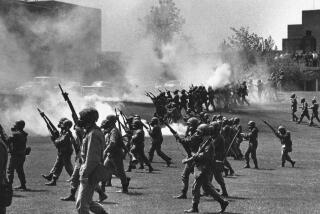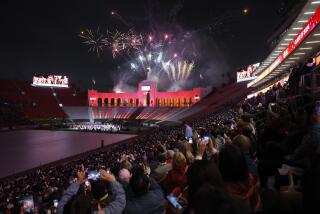Sorrow, solidarity with a postmark
- Share via
BLACKSBURG, VA. — The American Embassy in Vienna, Austria, sent a Virginia Tech flag that had flown over its building. Nike workers in Beaverton, Ore., sent a group photo with everyone in Hokie T-shirts. Lionel Virollet, a Frenchman in Abu Dhabi, sent a letter praising the campus police.
Linda Woodward of Luray, Va., sent a doll. Its dress was hand-crocheted in the school colors, maroon and orange, and covered in bows. “There is a bow for every soul that died,” Woodward wrote, in careful script. “Thirty-three in all, all little bows.”
More than three weeks after the worst shooting in modern U.S. history, Virginia Tech continues to be overwhelmed with expressions of sorrow and solidarity. Officials estimate that thousands, and perhaps tens of thousands, of items have been shipped to the campus from around the world.
Earlier this week, a small group of employees and volunteers sorted through box after box in a conference room in the Squires Student Center. Grade schools and colleges had sent hundreds of banners. Children had sent hundreds of cards, handmade and brightly colored, each delivering a message of regret.
“Let’s all hope this doesn’t happen again anywhere,” wrote Nate Burkholder, a student at Cocalico Middle School in Denver, Pa.
People have sent enough food to fuel a lifetime of wakes. The Hershey candy company delivered more than 7,000 pounds of chocolates coated in the school colors. A culinary institute sent 1,000 cookies. Those were followed by 4,000 snack-filled “care packages” from an alumnus in Texas. Strangers from afar sent boxes of potato chips and popcorn, while locals cooked hot dogs and hamburgers. Much of it was placed on tables at the student center and picked up by students cramming for finals.
An outpouring of support after a high-profile tragedy is nothing new in America: In 1907, the deaths of hundreds of miners in Monongah, W.Va., prompted a nationwide donation campaign for the victims’ families. More recently, gifts poured in to families of victims of the Sept. 11 attacks and the Columbine High School massacre.
But experts say the intensity of such responses probably has increased with the rise of live, 24-hour news.
“We’re much more in tune with the suffering people are going through by means of this instantaneous communication,” said Gordon Thornton, a psychology professor at Indiana University of Pennsylvania who studies death and bereavement. “You’ve got an outpouring of people who feel like they’ve got to make some kind of acknowledgment, some kind of statement.”
Virginia Tech officials are unsure what to do with all the offerings. Many are being displayed in a large tent on the school’s grassy Drill Field, behind a semi-circle of 33 stones laid in tribute to each of the dead. At the student center, countertops are piled high with a small sampling of the greeting cards. A glass case is filled with origami swans -- Japanese symbols of healing -- that were folded by students at Oregon State University.
This week, students and parents in town for graduation ceremonies walked among the displays, snapping pictures or stopping to read a message on a card or banner. A number of visitors broke down in tears.
“I could hardly comprehend all of the love,” said Kathy Campbell, 57, who toured the student center with her husband and son Murray, a freshman. “Out of a lot of evil came a recognition of all of the good that is in humanity.”
School employees including Steven Estrada were rushing to display as many of the items as possible before Friday’s main commencement ceremony. Instead of despairing that they couldn’t show everything, workers said they were grateful, as well as awed, by the enormous response.
“It’s a huge, huge hole that’s been created, basically, and part of the healing process is seeing how the hole is being filled,” said Estrada, an administrative assistant in the student activities department. “The one lesson I’m learning from this thing is how people take care of each other.”
Earlier this week, employees hung hundreds of colorful looped paper chains -- sent by students from Fort Wayne, Ind. -- above side doors in the student center. They hadn’t decided what to do with the seven boxes of teddy bears from Livermore, Calif.
Estrada offered a glimpse of items crowding the conference room: A velvety, maroon throw pillow festooned with little American flags on toothpicks. A framed, illustrated poem entitled “Beauty of a Butterfly.” A photo of victim Henry J. Lee at what appeared to be his high school graduation.
“This was the last time I saw Henh outside this building,” a note on the picture read. “All my love, Lewis.”
Estrada pulled out a small painting of a child releasing a red balloon in a vast cerulean sky. A woman named Marilyn Rogge had sent it, with little explanation.
Estrada, like many college employees, had been locked down in his office for much of the day on April 16. Initially, he said, he received the e-mail telling him that a gunman was loose and that he should stay away from the windows. It was only later that he learned that student Seung-hui Cho had fatally shot 32 people before killing himself.
Estrada stared at the red balloon. This one in particular, he said, got under his skin.
“It’s a total simplistic feeling, kind of like ... a childhood feeling,” he said. “You have to wonder what was going through her head.”
Across campus, Cara McFadden, a graduate assistant, and Carlos Munoz, an alumnus and volunteer for the day, were in a cramped room sorting about 30 boxes that had arrived that morning. They unpacked signed condolence books, candy and Tylenol, and an afghan made by Lisa Brazda, a homemaker from Papillion, Neb.
“Dear Virginia Tech: I crocheted this blanket in condolences of everyone that was injured and lost in this terrible tragedy,” Brazda wrote in an accompanying note.
“I’d be honored to be a good long distance friend in any way I can be,” she added, writing in her phone number.
“This is just overwhelming,” Munoz said, as he logged the items into a database.
No one is sure when to begin taking down the items on display.
Librarians will soon decide which items should be preserved. The school has already sought advice from Library of Congress archivists.
School officials say they would like to send a note to everyone who sent something -- yet another immense task.
Estrada has already thanked the man who came to campus last week with one of the most striking gifts: a few of his last days. The man, Estrada said, announced he was dying of prostate cancer and wanted to do something to help.
Estrada put him to work, hanging banners.
More to Read
Sign up for Essential California
The most important California stories and recommendations in your inbox every morning.
You may occasionally receive promotional content from the Los Angeles Times.










